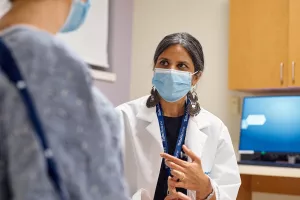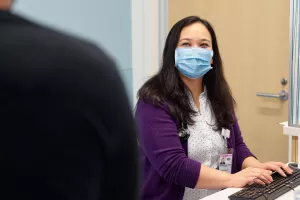Did you know that a vascular anomaly is when there is an unusual development of blood vessels? Sometimes you can see them as birthmarks, but in other cases, doctors need to use imaging tests to spot them.
Changing the mark
It's not uncommon for a child to be born with a vascular anomaly, commonly known as a birthmark. Birthmarks can vary in size, color and location—and some can only be seen with the help of an imaging scan—and many are considered minor. Other birthmarks need specialized care. This is where we come in, using the most advanced techniques to treat hemangiomas, vascular malformations, and anomalies, ensuring the best possible care for children.

Conditions
We specialize in caring for vascular birthmarks, hemangiomas, complex lesions such as capillary-lymphatic venous malformations and lesions associated with specific syndromes.
Arteriovenous malformations (AVMs) are abnormal connections between arteries and veins in the circulatory system of a child. These malformations are usually visible at birth and have a similar appearance to hemangiomas.
Blue rubber bleb nevus syndrome, sometimes called Bean syndrome, is a rare congenital vascular anomaly in which malformed veins, or blebs, appear on the skin and surfaces of internal organs. These small, purple lesions are particularly common in the gastrointestinal (GI) tract.
Capillary malformations are birthmarks that usually develop during fetal development. They occur when the capillaries, which are the smallest blood vessels, form abnormally. These birthmarks are commonly known as port wine stains and are often found on the head or neck at birth. When capillary malformations appear in other parts of the body, it may indicate additional underlying conditions.
Glomovenous malformations (GVMs) are a type of skin condition, where multiple venous malformations form causing the skin to appear dark blue. These malformations tend to increase in both size and thickness over time and can be quite painful for children when they are exposed to extreme temperatures or when they are bumped. Some of the medical interventions for GVMs include surgery, laser therapy and sclerotherapy.
Gorham's disease is a rare bone disorder characterized by bone loss, often associated with swelling or abnormal blood vessel growth. This bone loss most commonly affects the skull, shoulders and pelvis.
A hemangioma is a benign (not cancerous) tumor that develops in the cells lining blood vessels. It grows rapidly during the first few weeks of a child's life, known as the "proliferative phase." It eventually enters the "involuting phase," where it shrinks.
Hereditary hemorrhagic telangiectasia (HHT or Osler-Weber-Rendu syndrome) is an inherited disorder characterized by malformations of various blood vessels (vascular dysplasia), potentially resulting in bleeding (hemorrhaging) and shunting of blood.
Klippel-Trenaunay syndrome (KTS) is a rare, congenital vascular disorder in which a child's limb or limbs may be affected by port wine stains (birthmarks involving blood vessels), varicose veins or too much bone and soft tissue growth. The limb may be longer, larger or warmer than usual.
The lymphatic system transfers and collects fluids for the body's tissues. Lymphatic malformations are birthmarks that occur during fetal development when fluid accumulates in a particular area or lesion. Although they can occur anywhere in the body, lymphatic malformations are usually found in the head and neck.
It is common for midline venular malformations to occur, and they are also known as stork bites or angel kisses. These birthmarks typically have a light to medium pink color and are found in the middle of the forehead or on the back of the neck, but they can also appear between the eyes or on the eyelids. Generally, these marks fade gradually during the first few years of life and do not persist or darken. However, if the area remains visible into later childhood, laser treatments can be performed to reduce the mark's appearance.
Parkes-Weber syndrome is characterized by limb overgrowth, capillary malformations (port-wine stains) and diffuse arteriovenous malformations. It can affect the arms or legs. Long term, the disease can be associated with heart failure due to the shunt of blood from arteries to veins.
Sturge-Weber syndrome (encephelotrigeminal angiomatosis) is a congenital disorder characterized by a facial birthmark, neurological abnormalities, and eye and internal organ irregularities.
Telangiectatic nevi, also known as spider veins, are small dilated blood vessels near the skin surface that commonly develop on the face, particularly around the nose, cheeks and chin.
Venous malformations, or vascular malformations, occur when veins form abnormally during fetal development and become dilated. Although they are typically present at birth, they may not be apparent until later in adolescence or adulthood.
Venular malformations, or port wine stains, can occur anywhere on the body. These birthmarks often start as flat pink or red lesions and grow and darken with age.
Some of these port wine stains will eventually form small lumps on the surface called cobblestones. Currently, there is no cure for port wine stains, but laser treatment can be a very effective way to lighten the port wine stain and, in many cases, virtually disappear.
Treatments
We work together with a team of experts in pediatric surgery, hematology + oncology, pediatric head & neck surgery, dermatology, ophthalmology and interventional radiology to make sure that we can provide the best possible care for your child's vascular anomaly. We have a range of treatment options available, and we'll work together with you to find the best solution for your child.
- Genetic investigations
- Laser treatments (including pulsed dye laser for port wine stains)
- Imaging and embolization of high-flow vascular malformations
- Oral systemic corticosteroids
- Medication
- Sclerotherapy for low-flow malformations
- Surgical removal and laser therapy
FAQs
There are many great resources out there, but we usually suggest checking out:
- The Hemangioma Treatment Foundation
- Vascular Birthmarks Foundation

From regular office visits to inpatient stays, find the healthcare you need and deserve close to home.

Meet the doctors and care team devoted to supporting you every step of the way along your path to better health.